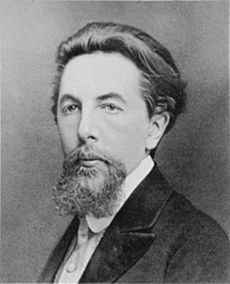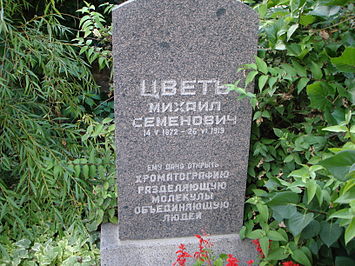- Mikhail Tsvet
-
Mikhail Tsvet 
Mikhail TsvetBorn 14 May 1872
Asti, ItalyDied 26 June 1919 (aged 47) Nationality Russia Fields botany Known for adsorption chromatography Mikhail Semyonovich Tsvet (Михаи́л Семёнович Цвет, also spelled Tsvett, Tswett, Tswet, Zwet, and Cvet) (1872–1919) was a Russian botanist who invented adsorption chromatography. His last name is Russian for both "colour" and "flowering."
Contents
Biography
Mikhail Tsvet was born May 14, 1872 in Asti, Italy. His mother was Italian, and his father was a Russian official. His mother died soon after his birth and he grew up in Geneva, Switzerland. He received his B.S. degree from the Department of Physics and Mathematics at the University of Geneva in 1893. However, he decided to dedicate himself to botany and received his Ph.D. degree in 1896 for his work on cell physiology. He moved to St. Petersburg, Russia, in 1896 because his father was recalled from the foreign service. There he started to work at the Biological Laboratory of the Russian Academy of Sciences. His Geneva degrees were not recognized in Russia, and he had to earn Russian degrees. In 1897 he became a teacher of botany courses for women. In 1902 he became a laboratory assistant at the Institute of Plant Physiology of the Warsaw University in Poland. In 1903 he became an assistant professor and taught also at other Warsaw universities. After the beginning of World War I the Warsaw University of Technology was evacuated to Moscow, Russia, and in 1916 again to Gorki near Moscow. In 1917 he became a Professor of Botany and the director of the botanical gardens at the University of Tartu (Yuryev) in Estonia. In 1918 when German troops occupied the city, the university was evacuated to Voronezh, a large city in the south of Central Russia. Tsvet died of a chronic inflammation of the throat on 26 June 1919 at the age of 47.
Chromatography
Mikhail Tsvet invented chromatography in 1906 during his research on plant pigments. He used liquid-adsorption column chromatography with calcium carbonate as adsorbent and petrol ether/ethanol mixtures as eluent to separate chlorophylls and carotenoids. The method was described on 30 December 1901 at the XI Congress of Naturalists and Physicians (XI съезд естествоиспытателей и врачей) in St. Petersburg. The first printed description was in 1905, in the Proceedings of the Warsaw Society of Naturalists, biology section.[1] He first used the term "chromatography" in print in 1906 in his two papers about chlorophyll in the German botanical journal, Berichte der Deutschen botanischen Gesellschaft.[2] In 1907 he demonstrated his chromatograph for the German Botanical Society.
Tsvet's work was ignored for several decades because of diverse reasons: the tragic events in Russia at the beginning of the 20th century, the fact that Tsvet originally published only in Russian (making his results largely inaccessible to western scientists), and an article denying Tsvet's findings. Willstater and Stoll tried to repeat Tsvet's experiments, but because they used an overly aggressive adsorbent (destroying the chlorophyll), were not able to do so. They published their results and Tsvet's chromatography method fell into obscurity. It was revived 10 years after his death thanks to German scientist Edgar Lederer, and Austrian biochemist Richard Kuhn and the work of Martin and Synge.
Botanical author abbreviation
The standard botanical author abbreviation Tswett is applied to plants he described.
References
- ^ Tswett, M. S. (1905) "O novoy kategorii adsorbtsionnykh yavleny i o primenenii ikh k biokkhimicheskomu analizu" (On a new category of adsorption phenomena and on its application to biochemical analysis), Trudy Varhavskago Obshchestva Estestvoispytatelei, Otdelenie Biologii (Proceedings of the Warsaw Society of Naturalists [i.e., natural scientists], Biology Section), vol. 14, no. 6, pages 20–39. (Note: Tsvet submitted his manuscript in 1903; however, it was not published until 1905.).
- ^ See: (1) Mikhail Tswett (1906) "Physikalisch-Chemische Studien über das Chlorophyll. Die Adsorption." (Physical-chemical studies of chlorophyll. Adsorption.) Berichte der Deutschen botanischen Gesellschaft, vol. 24, pages 316–326; and (2) Mikhail Tswett (1906) "Adsorptionanalyse und chromatographische Methode. Anwendung auf die Chemie des Chlorophylls" (Adsorption analysis and chromatographic method. Application to the chemistry of chlorophyll.), Berichte der Deutschen botanischen Gesellschaft, vol. 24, pages 384–393.
- Симон Шноль (Simon Schnoll), Герои и злодеи советской науки (Heroes and Villains of Soviet Science), Moscow, Kron-press (Крон-пресс), 1997.
- E. M. Senchenkova, Tsvet (or Tswett), Mikhail Semenovich (1872–1919). In: Ch. C. Gillispie (Ed.), Dictionary of scientific biography. American Council of Learned Societies, Charles Scribner Sons, New York, 13: 486–488 (1976)
- R. P. W. Scott, Liquid Chromatography, published by library4science (2003)
- A. J. P. Martin, R. L. M. Synge, Biochemistry Journal, 35, 1358 (1941)
- R. Willstater, A. Stoll, Untersuchungen über Chlorophyll , Springer, Berlin (1913)
- Ostrowski, W (1968), "Michael S. Tswett—inventor of column chromatography. (On the occasion of 65th anniversary of his lecture on the column chromatography technique).", Folia Biol. (Krakow) 16 (4): 429–48, PMID 4885242
External links
- Biography of Mikhail S. Tsvet (pdf, in German)
- Mikhail S. Tsvet: Physical chemical studies on chlorophyll adsorptions Berichte der Deutschen botanischen Gesellschaft 24, 316–323 (1906)
Categories:- 1872 births
- 1919 deaths
- 19th-century Russian people
- 20th-century Russian people
- 19th-century Italian people
- 19th-century botanists
- 20th-century botanists
- 19th-century scientists
- 20th-century scientists
- Russian botanists
- Russian inventors
- Botanists with author abbreviations
- Russian people of Italian descent
- Italian people of Russian descent
Wikimedia Foundation. 2010.

